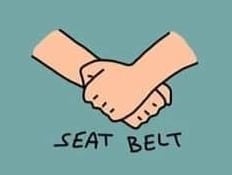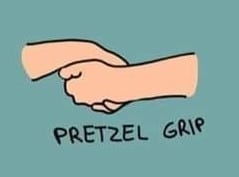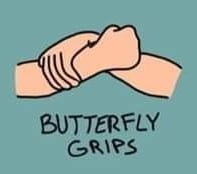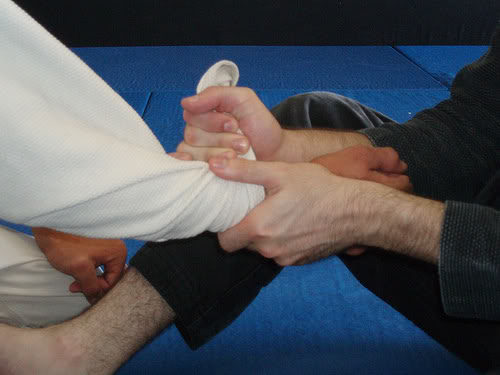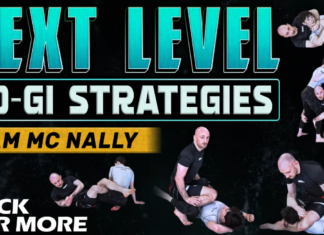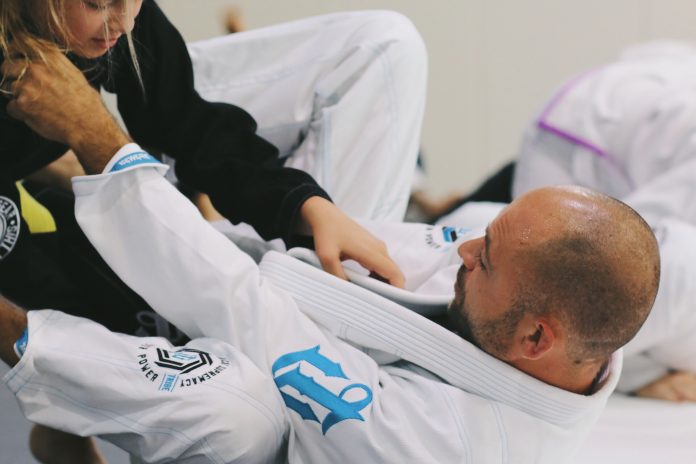
Today we’re going to talk about grips in Brazilian Jiu-Jitsu. But we’re not just going to talk about grips. We’re going to cover everything there is about BJJ grips and grips positions. Moreover, we’re going to look at all the best positions for gripping both Gi and No-Gi. Our guide is also going to explain all of the hand positions for different grips. Finally, we’re going to go over BJJ grip positions when you’re looking to connect your own hands. Grip fighting is the beginning of every grappling encounter, and you need to become a real master of it. Do not spend your white and blue belt time skipping overgrips, taking them for granted. You’ll have a hell of a lot to learn in order to catch up later on. They’re important, you can trust me about that.
The Art Of Grip Fighting
The thing with variety is that you need to know which variation fits which situation. You can’t look to use Gi pants grip on an opponent’s arm when rolling No-Gi. No-Gi grips are a bit more versatile and can be used in both. However, you still need to have options in order to be able to select the best grip for the best occasion. And remember, grip fighting is a dynamic, always changing affair.
So, what is grip fighting exactly? it is the battle for dominant leverage that precedes the “all-out” battle of grappling itself. With grips, the most important thing you’re hunting for is control. you’re trying to attach yourself to strategic parts of your opponent’s body in order to be able to control their overall movement. Next, you’re moving through a system of gripping in order to obtain your preferred attacking position. Finally, when you’re looking to execute anything, from escapes and sweeps to passes to submissions, you rely on grips.
All of the BJJ grip positions that you go through in a single match have stages to them. Grip fighting begins from a stalemate Both you and your opponent have the same opportunities to place grips. That said, whoever is more effective is going to manage to get into the position they want, regardless if its top or bottom. From there on, the grip fighting game changes to an offense-defense one. If you won the initial grip engagement, you’re on the offense. Your opponent should be looking to break your grips and establish his own superior ones. You, on the other hand, need to be looking to establish your own game, by constantly switching grip positions to increase control and leverage.
Gi vs. No-Gi Gripping
When it comes to BJJ grip positions, we have two major categories: Gi and No-Gi grips. When you start training Jiu-Jitsu with the Gi for the first time, you’re going to find yourself in a world of confusion. People are going to be wrapping you up tightly in every direction, using every little piece of cloth they can get their hands on. Even if you’re a highly accomplished wrestler, you’re going to have a difficult time with the Gi on, at least at first. This is all down to grips.
No-Gi grips, on the other hand, are completely different. While Gi grips provide indirect leverage over a limb or body area, No-Gi grips are direct. That also means they are way more dynamic, which is why the No-Gi game tends to be faster paced. When you’re gripping directly, there are more ways out compared to the high level of control the Gi offers. This means you’ll be involved in a BJJ grip battle most of the time. You’ll need to use those instances of domination to get to the next stage of your game, or you’ll have to start over again.
In both instances, two variables define the outcome. The first one is your grip choice. Whether you grip with a monkey grip or a C-grip, can completely change the direction of a match, for example. The second variable is the grip’s suitability for a given situation. You can go for both a monkey and a C-grip on many occasions. However, one is better suited for pulling, while the other is for pushing away. You need to know which to use in order to maximize your chances of advancing.
The Points Of Control With Grips
The main points of attaching yourself to an opponent are as crucial as the BJJ grip variations you are using. While you can grip an opponent everywhere, certain spots offer a much better control compared to others.
In Gi BJJ, the main grip positions are usually around three distinct points. The first is the sleeves, especially the ends near the wrists. The second position is the pants, once again, mainly at their end, towards the ankles. Finally, you have the collars and/or lapels, depending on the Gi’s position. These grip positions are the most fundamental ones for Gi Jiu-Jitsu. While there are other supplemental ones, these are the grips you’re using to execute every single move when rolling. Try to pay attention to it next time you’re in class.
In No-Gi, the grips are mainly on the arms, legs, and behind the neck. The grips behind the neck are a substitute for the collar grips in Gi BJJ. Gripping the limbs again revolves around controlling the ends of the levers, at the wrists and ankles. However, due to the fact that you’re gripping directly, hand positioning, and conversely, body positioning is way different in No-Gi Jiu-Jitsu. No matter which discipline is your favorite, you need the grip proficiency of both in order to be a successful grappler.
BJJ Grips For GI And No-Gi
Let’s go over some of the most basic hand positions in BJJ grip fighting. While the application of these grips is mostly in No-Gi, they often get used in Gi Jiu-Jitsu as well. So, let’s have a look at all the weapons at your disposal.
-
Monkey Grip
Well, start with the monkey grip. The monkey grip is a grip that involves using the four fingers of your palm, without the thumb. This doesn’t mean that the thumb is just floating there in mid-air. Instead, it is just tucked neatly next to your forefinger. For this grip, you’re removing the thumb’s main function – opposite direction movement. This makes your hand really strong for pulling your opponent towards your body.
-
C-Grip
The C-Grip is the opposite of the monkey grip. Here, your thumb goes in its natural position, opposite of the other four fingers. This is a pushing grip, one that’s most useful to push your opponent away.
-
Figure-Four Grip
The figure four grip is mostly used for finishing although it might also be a controlling grip. For that, you need to have one palm gripping the other arm’s wrist in a figure four configuration. Think of a Kimura, Americana, Toe Hold…
-
Gable Grip
Finally, you have the grip positions that connect your own hands to each other. While there are numerous variations here, only two BJJ grip positions really matter – the Gable grip (palm to palm) and the S-grip (four fingers of one palm connecting to four on the other).
-
S-Grip
-
Socket Grip, Ball Grip, or Seat Belt grip
-
Pretzel Grip
-
Butterfly Grip
-
Gokor Grip
BJJ GI Grips
For the Gi, you need to understand that you need to have a very tight grip on the material, in order to have control over an opponent. Since we already covered the main gripping spots, I’m just going to go over the few main positions of your arms. Gripping the material requires different positioning to No-Gi grips.
So, the most common one is using four fingers to create a “pocket” in your opponent’s Gi. In this case, the thumb goes on the outside to secure everything in place. This grip can also work in reverse, with the thumb in and four fingers out, although this is mainly for collar gripping. Next up is the pistol grip, when you grip the material like a handle of a pistol, thumb on top. For people that wear large-sleeved Gis, this is the grip to use.
Collar Grips
Collar grips have two main purposes. The first is to control the opponent’s shoulder girdle. The second is finishing an opponent via a choke. Unless you’re going for a rear-naked choke, you’re going to need the collars in order to finish an opponent.
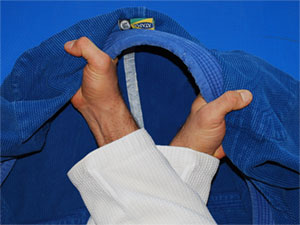
For collar gripping, there are two main BJJ grip positions that you should rely upon. The first one is the most basic four fingers in the grip. For this, you need to place all your fingers except for the thumb deep inside the collar of an opponent. The goal is to grip the material tight by bending your fingers into a fist. The thumb has the role of securing the grip in place from the outside. The main uses of this grip are for control, from both the top and bottom position. In certain cases, you might even use it to finish, like with a loop choke.
The thumb in grip is the exact opposite of the previous one. For this, you need to have your thumb deep inside the collar, with your other fingers gripping the outside of the Gi. The main uses of this grip are usually from back control, although you can use it from the guard as well. There are plenty of cooking options with this grip.
Pants Grips
When it comes to controlling the pants, you either need to keep them in place, in order to work from the bottom or move them aside to pass from the top. In both cases, you need a firm grip.
- Four Fingers Grip or Pocket Grip on GI pants is usually the first choice. Just like before, you use four fingers to grip the material. The trick here is not to place the four fingers inside the pants, as this is illegal in competition. Instead, you need to form a pocket on the pants, using your fingers to make a fist again and trap the material.
- The pistol grip is one that’s not used often for the pants. From the bottom, it doesn’t offer much, but it is a BJJ grip to consider from the top. It offers much tighter control over the material at the ankle level. This results in a much higher degree of control over the leg and easier passing in turn.
Finally, remember that you can also create pockets at knee level, and below, for increased control of the shins.
Sleeve Grips
The sleeves have two major points of connection. The first and much more commonly used is the end of the sleeve just above the wrist. The second is either above the elbow (triceps level) or high in the armpit. Sleeve grips at wrist level are much more reliable though, given the type of material and the tightness of the Gi at upper arm level.
- The Four Fingers Grip or Pocket Grip in BJJ is the king. It offers huge control in multiple directions. The gripping mechanism is the same as with pants grips. Again, gripping inside the sleeve is illegal, so make sure you keep all your fingers except the thumb out. Creating a pocket in order to obtain as much material as possible is once again the way to go.
Four Fingers Grip - Pistol Grip is much more important with sleeves than they are with pants. Unless the opponent’s Gi is very tight around the wrists you can grip it like a pistol handle once again. This means your pinky is nearest to their wrist, with all your fingers holding as much of the material as a pistol handle. It is a great way to increase control over the opponent, plus add some discomfort due to the tightness of the sleeve.
Pistol Grip - Upper Arm Grips: For upper arm grips, the best place to grip is behind the triceps and the best method is with a modified four-finger grip. The trouble is that you do not have much material so upper arm grips need only be temporary solutions in a gripping fight.
No-Gi BJJ Grips
This is where things get interesting. Since No-gi grips offer much less control, there are much more of them. Do not be afraid of the sheer number of No-Gi BJJ grip positions. The gripping principles are similar to Gi Jiu-Jitsu and the goal is exactly the same – control or finish.
Arm Grips
Arms control is of the utmost importance in No-Gi BJJ. No-Gi is much more dynamic and submissions could come in a blitz. If you control the opponent’s arms, though, you’ll be able to prevent any surprises they might throw your way.
The basic control patterns of the arms are in regard to how many limbs of yours you’re going to use in order to control theirs. Gripping is done exclusively with the C-grip although you need to be able to change it from thumb up to thumb down as their arms move.
The best way to control someone is to use both your arms to control one of theirs.
-
Basic Two on One Grip
The basic two-on-one BJJ grip is with both your hands wrapped around an opponent’s wrist. This makes it extremely difficult for them to escape and opens up multiple avenues of control and attack for you.
-
Wrist and Elbow Grip
Wrist and Elbow grip The second applicable variation is a wrist and elbow grip on the same arm. For this, you’re going to use one C grip behind the opponent’s elbow, and another on the opponent’s same arm wrist. It’s a great way to go into arm drags and similar attacks and offers much better control than the double wrist grip.
-
Arm Drag 2 on 1 Grip
-
Two C-Grips on Wrist
-
One on One Grip
Alternatively, you can go for one-on-one grips, controlling each arm with one of yours. This engages both arms but sacrifices a lot of control in order to do so.
Hooks
These are the quintessential No-Gi BJJ grip positions. That said, you’ll find these used in the Gi very often as well. Hook grips mean using your arms to control either an arm or the opponent’s torso.
Underhooks are crucial for both passing and sweeping. There’s no way past the half guard, or out of it unless you rely on underhooks. For this, you need to place your arms shoulder deep under the opponent’s armpit, your palm should come out behind and stay on the back of the neck. While this is not as much a grip as it is arm positioning, it still plays right into grip fighting. You can go for underhooks on one side only, or on both sides of an opponent.
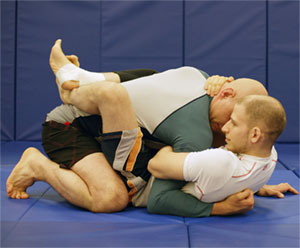
Head Control
Head control in BJJ without the Gi is rarely something you look for on its own. Having a Thai Cinch-like position might be helpful in very few instances. instead, people usually opt for head and arm control which is much better. Namely, you want one of your arms controlling either the wrist or the elbow of an opponent, as described before. The other one is going to go at the back of the neck, similar to a Thai clinch. This offers both direct arm control and postural control via the neck. It is another grip combination essential for No-Gi.
-
Chin Strap
A direct way of controlling the head is via a chin strap. Mostly it’s limited to the front headlock position but it is a crucial concept to have. For the chin strap, you need a monkey grip under the opponent’s chin while you’re in a front headlock position. This offers huge control as well as plenty of choking or transitioning opportunities. You can also use a chin strap grip to escape some submissions like head and arm choke from the north&south position.
-
Collar Tie
Leg Grips
Leg control without the Gi is a very fleeting thing. As such, controlling the legs is usually only temporary, unless you’re going for leg locks. To that extent, the basic control points are the foot, ankle, and knee.
-
Ankle Control
Ankle control is by far the most common and useful one. With the legs, suing a C-grip is counter-productive, because they’re generally much stronger than your arms. So, a monkey grip to either hold them in place or pull them in the best option here. You can go for a monkey grip in both outside and inside directions, depending on your positioning and goal.
-
Knee Control
For knee control, once again you need to rely exclusively on the monkey grip. The best way to control the knees is to place the fingers right behind the tendons of the knee joint. This offers a great anchor for your grip as well as huge control over an opponent. Keep in mind that knee grips are much more useful when the leg is bent.
-
Foot Control
Finally, a BJJ grip that grapplers seem to often overlook is foot control. Grabbing the foot of an opponent with a C-grip can do wonders for your passing game. Give it a try next time when you’re on top.
Final Thoughts
Grips are among the most varied Jiu-Jitsu techniques you’ll learn. I only discovered the importance of grip fighting after a few years of training and had to spend a lot of time learning the nuances. Grip fighting is a topic for a completely different article, one that we’ll revisit in the future. We’re also going to skip over grip breaking for the time being. Today we focused on the ways in which we can place grips on our opponents. The idea of grips is to provide you with control over an opponent. Depending on the grip variety, you can have direct control (No-Gi) grips, or indirect control (Gi grips). Both have the task of providing you with maximal leverage over the important body parts of your opponent.
The same need for grips arises both standings, and on the ground, in every position, you’re going to find yourself when grappling. You might not consider the grip game very important yet but think about this for a moment. Can you really pull off anything without getting a hold of the opponent? In Brazilian Jiu-Jitsu, there’s no way to achieve such a thing. To that extent, all high-level coaches explain a great variety of BJJ grip positions early on and make students focus on the most effective ones.










 Well, start with the monkey grip. The monkey grip is a grip that involves using the four fingers of your palm, without the thumb. This doesn’t mean that the thumb is just floating there in mid-air. Instead, it is just tucked neatly next to your forefinger. For this grip, you’re removing the thumb’s main function – opposite direction movement. This makes your hand really strong for pulling your opponent towards your body.
Well, start with the monkey grip. The monkey grip is a grip that involves using the four fingers of your palm, without the thumb. This doesn’t mean that the thumb is just floating there in mid-air. Instead, it is just tucked neatly next to your forefinger. For this grip, you’re removing the thumb’s main function – opposite direction movement. This makes your hand really strong for pulling your opponent towards your body.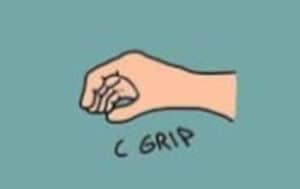 The C-Grip is the opposite of the monkey grip. Here, your thumb goes in its natural position, opposite of the other four fingers. This is a pushing grip, one that’s most useful to push your opponent away.
The C-Grip is the opposite of the monkey grip. Here, your thumb goes in its natural position, opposite of the other four fingers. This is a pushing grip, one that’s most useful to push your opponent away.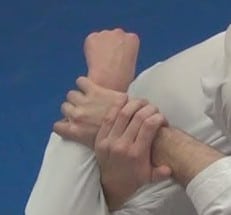 The figure four grip is mostly used for finishing although it might also be a controlling grip. For that, you need to have one palm gripping the other arm’s wrist in a figure four configuration. Think of a Kimura, Americana, Toe Hold…
The figure four grip is mostly used for finishing although it might also be a controlling grip. For that, you need to have one palm gripping the other arm’s wrist in a figure four configuration. Think of a Kimura, Americana, Toe Hold… Finally, you have the grip positions that connect your own hands to each other. While there are numerous variations here, only two BJJ grip positions really matter – the Gable grip (palm to palm) and the S-grip (four fingers of one palm connecting to four on the other).
Finally, you have the grip positions that connect your own hands to each other. While there are numerous variations here, only two BJJ grip positions really matter – the Gable grip (palm to palm) and the S-grip (four fingers of one palm connecting to four on the other).
